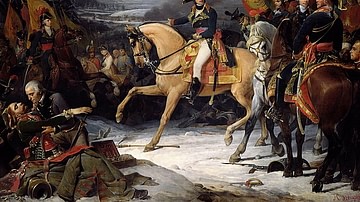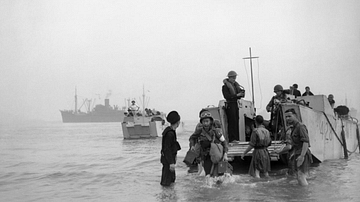The Allied victory in North Africa was achieved in May 1943 after three years of indecisive battles across the region. Outnumbered and with its supply lines compromised, the Axis German-Italian army lost the Battle of Medenine before being overwhelmed at the Mareth Line of defences around Tunis. The massive Allied land, air, and sea presence combined US, British, British Empire, and Free French troops, who worked together to bring victory in the Tunisia Campaign. With control of North Africa, the Allies could proceed with the next stage of the war: the invasion of southern Europe.

The Importance of North Africa
Right from the start of WWII, North Africa was recognised by both sides as having crucial strategic value. Whoever controlled North Africa could also control vital Mediterranean shipping routes, while the Suez Canal was the lifeline between Britain and its eastern empire. In addition, Egypt remained a bulwark of defence for the British-controlled oil fields of the Middle East. For the Italian Fascist leader Benito Mussolini (1883-1945), North Africa presented a tantalising vision of an Italian Empire that could finally rival that of France and Britain on the continent.
The Western Desert Campaigns had gone back and forth between 1940 and 1942 as Axis and Allied forces shared victories and losses. The tide began to turn definitively following the Allied victory at the Second Battle of El Alamein (October-November 1942). Here the British Eighth Army led by General Bernard Montgomery (1887-1976) crushed the Axis army led by Field Marshal Erwin Rommel (1891-1944). This was followed a few days later by Operation Torch, the amphibious landing of three Allied armies in French Morocco and Algeria. The Axis armies were pushed back into holding a small pocket in Tunisia around the port of Tunis. The Allied objective now was to take total control of North Africa, which would permit an invasion of Axis-occupied Europe starting with Sicily and then mainland Italy, as had long been promised to Britain's and the United States' ally Russia, then fighting alone on the Eastern Front.
The Axis powers had been cornered in Tunisia, but they still had some bite, as was shown in Rommel's victory against mostly inexperienced US troops at the battle of Kasserine Pass in February 1943. In the long term, though, the Allies were now shipping in so many men and material to North Africa that the Axis days were numbered there, especially as their own supply lines became increasingly imperilled by Allied bombing and naval attacks. The Allies could field 19 well-equipped divisions against the depleted 13 Axis divisions left in Tunisia. "Nearly 1,200 Allied tanks were concentrated against 130 belonging to the Axis; in artillery 1,500 guns were opposed by just under 500; and in the air over 3,000 aircraft dominated 500" (Liddell Hart, 278).

The Medenine Delay
With Montgomery's army closing in from the east and the 2nd US Corps led by General George Patton (1885-1945) moving in from the west, the Axis presence in North Africa was in serious danger of being pushed into the sea. However, any delay in the fall of Tunisia would mean a planned invasion of Italy could not take place in summer but in the autumn when weather conditions would be much less favourable to an amphibious operation. With this in mind, Rommel considered, as he very often did, that an attack was the best form of defence. The place would be Medenine.
The Allies won the Battle of Medenine on 6 March 1943 when the British Eighth Army rebuffed Rommel's advance, his final one in Africa. Montgomery had been warned by military intelligence of Rommel's plan to attack the vanguard of the Eighth Army. The battle became "a model of defensive fire-power at its most destructive" (Strawson, 224) where the Allies fielded an overwhelming superiority in anti-tank guns, artillery, tanks, and troops, all protected by a formidable layer of hastily laid minefields. The Allied anti-tank gunners were particularly effective, and all Axis units, both German and Italian, took heavy casualties, even the Afrika Korps, which alone lost 55 tanks and 600 men in the battle. There was now nothing between the Allies and their goal, the last remaining obstacle to total victory: the Mareth Line.
Changes on Command
Overall command of Allied forces in the region was in the hands of Lieutenant-General Dwight D. Eisenhower (1890-1969), but the troops on the field, now organised into a single Allied army, Eighteenth Army Group, were commanded by General Harold Alexander (1891-1961). Amongst the various nations all fighting on the same side were Americans, British, British Empire troops (notably the Indian and New Zealand divisions), French, and French colonial troops. Alexander's brief was to forge this motley group into a single fighting unit and complete the North Africa Campaign by April 1943, a feat which would allow the Allies to conduct an amphibious invasion of Sicily in the summer.

The Axis army, the newly named First Italian Army (formerly the German-Italian Panzer Army), was commanded by Marshall Giovanni Messe (1883-1968) since Rommel had been promoted to commander-in-chief of Group Africa, although he soon returned to Germany (on 9 March) with a serious illness, never to return to the North Africa Campaign. Rommel tried to persuade both the leader of Nazi Germany Adolf Hitler (1889-1945) and Mussolini in personal meetings that North Africa desperately needed more Axis resources, which would allow him to withdraw his army intact. Such an army could then be used where most required to protect the southern flank of Europe. The field marshal was also keen to return to the men he had led through thick and thin, but, as he himself realised, "All of my efforts to save my men and get them back to the Continent had been fruitless" (Allen Butler, 439). The Axis force in North Africa – composed of Messe's First Army at Mareth and the 5th Panzer Army in northern Tunisia commanded by General Hans-Jürgen von Arnim (1889-1962), who replaced Rommel as commander-in-chief of Group Africa – was ordered to stay until the end whatever the outcome as both Hitler and Mussolini refused to see the reality that capitulation was only a matter of time.
The Mareth Line
In the final week of February 1943 Montgomery finally completed his slow advance from El Alamein and was ready to attack the Mareth Line of Axis defences in the south of Tunisia. These defences, actually built by the French before the war, stretched from the coast to the Matmata Hills. The line was some 22 miles (35 km) long and included many fortified hills, which could protect neighbouring defensive positions. There were trenches, concrete blockhouses, steel-protected gun emplacements, and masses of mines and barbed wire. Some 80,000 Axis troops defended the Mareth Line, around half the men under Montgomery's command.
Montgomery, in Operation Pugilist, chose to attack head-on at the southern part of the line with three infantry divisions and one armoured division. At the same time, a New Zealand force was tasked with attempting to outflank the line and attack from behind. The New Zealander Division was led by Lieutenant-General Bernard Freybourg (1889-1963) and was already known as "one of the toughest, most hard-hitting combat formations of the war" (Dear, 332). The defenders were a mix of German and Italian troops. Both sides were well-matched in terms of troop numbers, but the Allies had superior weapons overall and far more tanks.

The frontal attack, which began on 20 March 1943, was driven back by determined Axis resistance, and so Montgomery strengthened the New Zealanders in the left flank manoeuvre with fresh troops and artillery units. Inroads were made against the Italian-held defences, but then German reserves regained these lost positions. Meanwhile, the Western Desert Air Force made repeated strikes at the Axis defences, often flying over 700 sorties a day. The Allies finally broke through the Mareth Line near Tebaga on 27 March. A rearguard action at El Hamma allowed Messe to retreat northwards with some of his force to another defensive line: Wadi Akarit, a tangle of escarpments and ravines that presented the last natural barrier to the plain that ran up to Tunis. The Wadi Akarit line was shorter and more formidable than Mareth, which is why Rommel had initially wanted to make a stand here, but he was counterordered by his superiors. Now, after the heavy losses sustained defending Mareth, the Axis force led by Messe was not large enough to properly defend the whole of the Wadi Akarit line. The Allied commanders immediately spotted where the weak link was in the chain of defences that blocked their advance. The attack was launched on the night of 5 April.
By this time, Patton's First US Army Corps was approaching from the west to squeeze the Allied vice and draw off both the 10th and the 21st Panzer Divisions from Montgomery's attack. General Omar Bradley (1893-1981) was also approaching with the Second US Army Corps. Messe had almost exhausted his ammunition, fuel, and food supplies. With the Allies applying a total naval blockade on the Axis supply lines across the Mediterranean, Messe had little hope of improving his situation. Meanwhile, the second Axis army led by Arnim was also being pushed back towards the coast.

Montgomery's army continued its advance, eventually obliging Messe to also retreat from Wadi Akarit. The Eighth Army had suffered 1,289 casualties fighting for Wadi Akarit, but they had smashed it and taken around 7,000 prisoners. Patton and Bradley were also moving forward as the Axis defenders were still offering significant resistance in various pockets, aided by the mountainous terrain but hampered by the increasing fragmentation of the Axis chain of command. The fighting had been brutal, as remembered by one New Zealand soldier:
In the darkness men grappled and slew each other. The survivors went to earth as bombs burst about them, rose and rushed forward in the dust and smoke, and fastened upon enemies…Every gain drew a counterattack from desperate men pledged to hold the heights at all costs. Yard by yard the assailants worked upwards, around rocky knolls, across mountain wadis, surging over crests to face other crests from which mortar and small arms fire swept down incessantly upon them.
(Liddell Hart, 280)

General Alexander, now with three armies at his disposal, two of which had already been cooperating with each other in the battle, launched on 22 April the final move of the game: Operation Vulcan. It was the turn of the US commanders to take centre stage. Arnim's army was on the Medjez-Tunis road, and this area was attacked by Patton. Bradley at the same time attacked Bizerta, west of Tunis. The 19th French Corps pushed up to Pont du Fahs. Fighting was especially fierce at such places as the Battle of Longstop Hill (22-26 April) and the Battle for Hill 609 (28-30 April). The progress was slow for the Allies, some 1,000 yards (900 m) per day only as the Axis defences had to be systematically cleared. At the same time, the Axis force could still not receive fresh men or supplies. Two German troop carriers and one ship of ammunition headed for Tunis were sunk on 30 April by the Desert Air Force. Arnim, by now, had just 69 tanks left, and none of them could move because of a lack of fuel. As Rommel had once stated in a letter home to his wife, the key to success in Africa was logistics: "Everything depends on supplies – and has done for years" (Strawson, 225). With their supply lines in tatters, the Axis commanders knew that total defeat was only a few days away.
The Axis Surrender
Alexander consulted with Montgomery and two divisions and a brigade were sent to strengthen Patton's force along the Medjez-Tunis road. This final push, code-named Strike, was conducted on 6 May, and, with massive and unopposed air support, it overwhelmed the Axis armies through a narrow front in the Medjerda valley. Tunis, Bizerta, and Pont du Fahs were all captured in the next few days. Pockets of Axis troops, mostly the elite Afrika Korps, continued to fight on, but on 9 May, one Axis army surrendered, and on 13 May, the wider surrender was announced. The Allies had definitively removed the Axis powers from North Africa. General Alexander sent the following signal to the British Prime Minister Winston Churchill (1874-1965):
Sir, it is my duty to report that the Tunisian campaign is over. All enemy resistance has ceased. We are masters of the North African shores.
(Holland, 704)

Around 250,000 Axis prisoners of war were taken. Many prisoners were shipped to Canada, not to return home to Europe until 1947. The loss of Axis soldiers was greater than at the terrible defeat in the Battle of Stalingrad two months before. Mussolini's dreams of empire had proved nothing more than a wishful mirage. In the capital, Tunis, Allied tanks had flowers thrown at them by the delighted locals. The Bey of Tunis was replaced as ruler of Tunisia by the French general Henri-Honoré Giraud (1879-1949).
The Allied victory in North Africa finally secured a platform from which they could attack Axis-occupied Europe through Italy, what Churchill had described as "the underbelly of the Axis" (Holland, 430). The campaign also gave commanders and troops invaluable experience which could now be applied to the European campaign. The training methods, command organisation, the use of combined troops (infantry, artillery, and armour), the testing and development of weapons and machines in battle conditions, and the coordination between air support and ground operations had all improved immeasurably throughout the North Africa Campaign. The Allied invasion of Sicily began on 9 July 1943 and was quickly followed up by Allied troops landing on mainland Italy, ultimately leading to the fall of Mussolini's regime on 25 July. Italy signed an armistice on 3 September, and so Germany was left alone as the Allies closed in from all directions. As Churchill famously noted after the victory in Africa: "Now this is not the end. It is not even the beginning of the end. But it is, perhaps, the end of the beginning" (Mitchellhill-Green). The tide of the war had changed.





